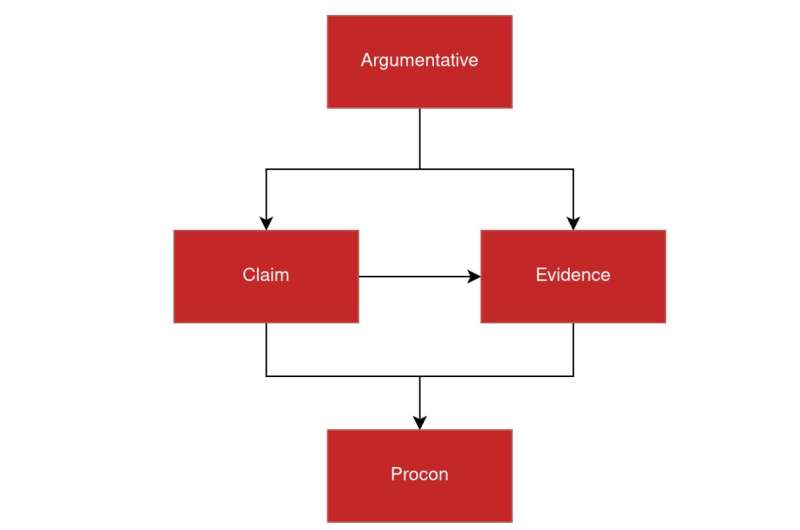Dependencies between annotation rounds. Credit: A Dataset of Sustainable Diet Arguments on Twitter (2023).
Experience and opinion trump fact in Twitter conversations about sustainable food. In a new study, University of Copenhagen researchers demonstrate that natural language algorithms make it possible to identify people's attitudes on social media towards sustainable food. It's a step forward that can enlighten politicians and public agencies with regards to how to nudge society in the right direction.
Billions of new posts appear on social media every day, created by users around the world, of all ages and social classes. If one is interested in knowing how people feel about things like plant-based food, social media content could be an invaluable source of information. By using this information, one can influence food habits in a more climate-friendly direction through communication and nudging.
There's just a few problems: there is a lot of information, it is far from uniform and can be found in a hodgepodge of posts on Twitter and other social media platforms. Researchers at the University of Copenhagen's Department of Computer Science set out to investigate whether one can, with the help of language models and artificial intelligence, map people's attitudes about climate-friendly foods. And yes, it can be done.
The researchers developed a method that can be used to examine people's attitudes by way of a computer analysis of 30,000 tweets about sustainable and climate-friendly foods. According to Assistant Professor Daniel Hershcovich, the study's co-author, the knowledge could be used to promote sustainable behavior through better communication to consumers.
"Suppose the Ministry of Food, Agriculture and Fisheries wants to create a new campaign to get more people to eat plant-based foods. What should their primary messages be? They can focus on what most of us already know—that limiting the carbon footprint of one's diet is good for the climate. But there are many other arguments based on cultural and social perspectives that we haven't even considered, ones that can be found on social media," says Hershcovich from the Department of Computer Science.
Experience and opinion trump facts
The area of research is known as "argument mining." The goal of argument mining is to automatically identify and extract arguments from natural language text obtained from sources including social media, with the help of computer algorithms. In their study, the researchers went one step further and applied artificial intelligence to help them sort through the mountains of arguments found on Twitter.
"Simply put, this means that we can use computers to help us gain an overview of large amounts of information and divide it all into categories that make sense for understanding what people think about a given topic, like sustainable eating, and what their opinions are based on," explains Daniel Hershcovich.
To that end, the researchers developed an algorithm that divided thousands of tweets about sustainable food habits into categories that, among other things, show whether the tweet was written based on a person's own experiences, or refers to an expert, study, facts about the subject, or the author's belief or opinion.
"In the study, we can see that many people use their beliefs as evidence to back their stance on sustainable eating, whether it be positive or negative, without it being linked to a study or an expert in a scientific article, for example. Arguing in this manner is commonplace on social media," says Daniel Hershcovich, who adds:
"People's experiences and stories are shared and discussed much more often than factual information from experts and the media. It says something about the personal approach that agencies and ministries may need in their communication in order to connect with people and get them to change their behavior."
The study proves that the method works
According to the researcher, the new research result is a "proof of concept" for the possibility of using computers and artificial intelligence to map people's attitudes on social media.
"We developed a prototype that proves that the method works. But for us to really use the data extracted by the computer, a tailored study must be designed for the topic that one seeks to investigate. I hope that we get the chance to do so soon," says Daniel Hershcovich.
Hershcovich believes that the method has great potential to contribute new and important knowledge that can enlighten public agencies, politicians and others as they design campaigns and communication targeted at citizens.
"By deploying artificial intelligence and having a data-driven approach to human behavior and attitudes on social media, we can find new areas that we wouldn't otherwise be able to spot with the human eye. It can help us understand why some people choose sustainable diets while others don't, knowledge which can be used to promote sustainable behavior and hopefully push society in a more climate-friendly direction," he concludes.
How they did it:
- The researchers analyzed 30,000 Twitter posts about sustainable food using an algorithm they developed.
- The researchers used a computer program to analyze social media posts and categorize them as containing arguments for or against certain topics related to sustainable food.
- These topics included reducing meat consumption, promoting plant-based diets, encouraging alternatives to meat, advocating for vegan and vegetarian diets, and supporting policies that promote sustainable food.
- The posts were also marked based on what type of argument they were and where the knowledge or opinion expressed in the post came from: whether they were anecdotal, expert opinions, factual, study results or moral beliefs.
More information: Paper: A Dataset of Sustainable Diet Arguments on Twitter
Provided by University of Copenhagen
























